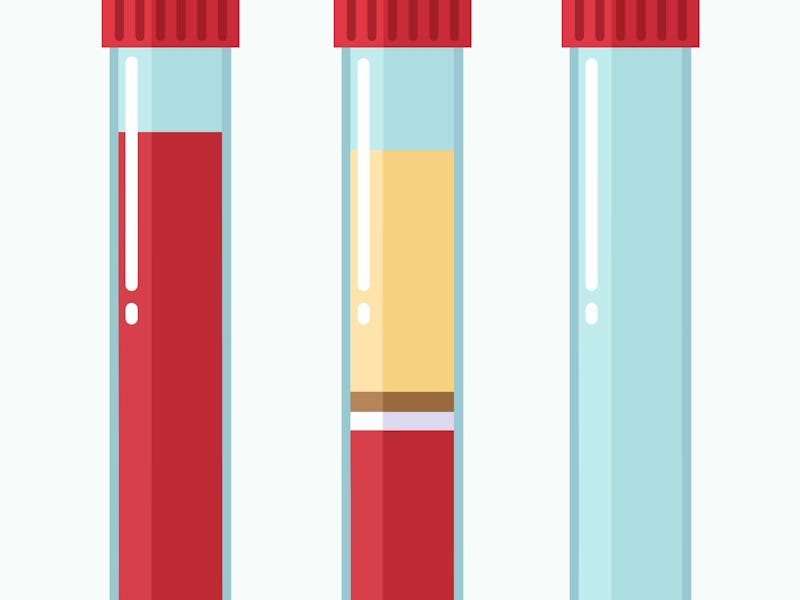This app can analyze your blood without ever touching you
But first, you have to give it the stink eye first.

When it comes to detecting disease, blood is an incredibly powerful medical tool. But coming into the office to get your blood drawn and analyzed these days can present more risks than its worth.
To mitigate these risks and help patients continue to monitor their health outside the office, scientists have designed a mobile health app called mHematology that allows patients to measure their hemoglobin -- a protein in red blood cells that carries oxygen -- using only a smartphone. This application was able to produce results on par with those of traditional blood-drawing methods without the costly overhead or additional tools.
Particularly now, as people continue to socially distance and avoid unnecessary excursions, improving telemedicine options is more important -- and feasible -- than ever.
"The COVID-19 pandemic has greatly increased awareness of the need for expanded mobile health and telemedicine services."
In a new study, published Thursday in the journal Optica, an international group of researchers from the U.S. and Kenya describes the kind of diseases their app would be able to detect, ranging from blood disorders and hemorrhages to anemia -- the latter of which affects a quarter of the global population, especially those in developing areas.
"Our new mobile health approach paves the way for bedside or remote testing of blood hemoglobin levels for detecting anemia, acute kidney injury and hemorrhages, or for assessing blood disorders such as sickle cell anemia." research team leader and professor of biomedical engineering at Purdue University, Young Kim, said in a statement. "The COVID-19 pandemic has greatly increased awareness of the need for expanded mobile health and telemedicine services."
Researchers designed an app that was able to measure patients' hemoglobin levels using only pictures taken on a smartphone.
Measuring patients' hemoglobin levels can often be an easy way to assess whether they have one of these diseases or disorders, but the researchers say that these processes can either be invasive or expensive. Additionally, there is a limit to how many times a patients' blood can be drawn before it becomes dangerous, which makes real-time monitoring a challenge.
Instead, researchers skipped the blood-drawing altogether and opted for something less hands-on: a smartphone app. This app is designed to take pictures of a patient's inner eyelid and transform the RGB color values of their veins into data-rich waveforms.
"In SSR [spectral super-resolution spectroscopy], hyperspectral data in the visible range are mathematically reconstructed from an RGB image," write the authors. "In other words, it intends to solve an ill-posed problem as an inverse mapping from a subsampled space (three color values) to a dense space (multiple wavelengths)."
Essentially, the team used algorithms to process color information from the patient's eyelids and match it to distinct hemoglobin levels by comparing their unique light absorption patterns. Kind of like shining a light on a hung-up sheet and measuring whatever shadow puppets were being made behind it.
To use the app all patients need to do is pull down their lower eyelid -- effectively giving the smartphone the stink eye.
To test their approach the team recruited 153 volunteers who were referred to the Moi University Teaching and Referral Hospital in Kenya for conventional blood tests. The team trained their algorithm on data from 138 of the volunteers and tested it on the remaining 15. In order to use the app, participants pulled down their lower eyelids and averted their gaze as the app turned on the smartphone's flashlight and took photos of the exposed eyelid.
After processing the image information the team found that predictions of hemoglobin levels made using the app were only about five to ten percent different than those made using traditional methods.
The authors write that mHematology still has to go through much larger clinical trials before it can possibly be made widely available to patients, but Kim has hope that their app will help make this critical medical evaluation more accessible for those in low-income or developing areas in the near future.
"Our work shows that data-driven and data-centric light-based research can provide new ways to minimize hardware complexity and facilitate mobile health," says Kim. "Combining the built-in sensors available in today's smartphones with data-centric approaches can quicken the tempo of innovation and research translation in this area."
Abstract: Although blood hemoglobin (Hgb) testing is a routine procedure in a variety of clinical situations, noninvasive, continuous, and real-time blood Hgb measurements are still challenging. Optical spectroscopy can offer noninvasive blood Hgb quantification, but requires bulky optical components that intrinsically limit the development of mobile health (mHealth) technologies. Here, we report spectral super-resolution (SSR) spectroscopy that virtually transforms the built-in camera (RGB sensor) of a smartphone into a hyperspectral imager for accurate and precise blood Hgb analyses. Statistical learning of SSR enables us to reconstruct detailed spectra from three color RGB data. Peripheral tissue imaging with a mobile application is further combined to compute exact blood Hgb content without a priori personalized calibration. Measurements over a wide range of blood Hgb values show reliable performance of SSR blood Hgb quantification. Given that SSR does not require additional hardware accessories, the mobility, simplicity, and affordability of conventional smartphones support the idea that SSR blood Hgb measurements can be used as an mHealth method.